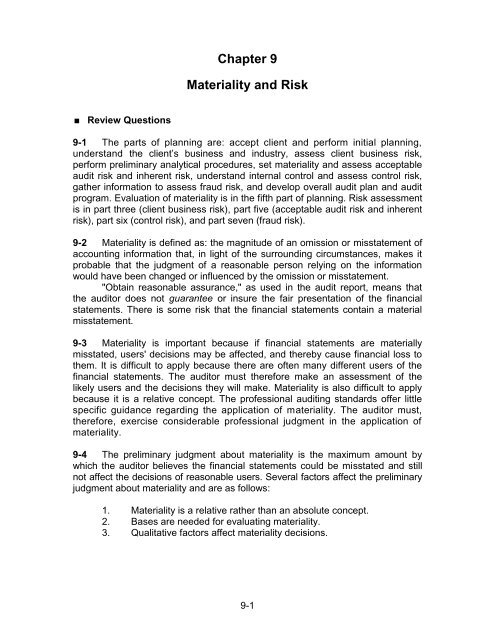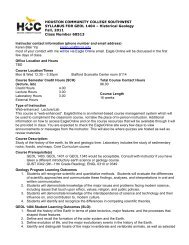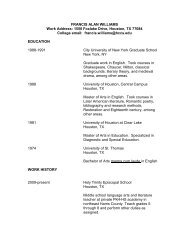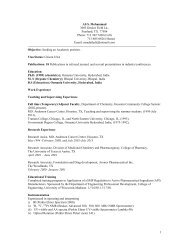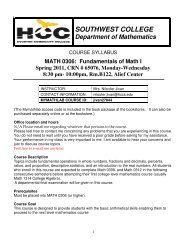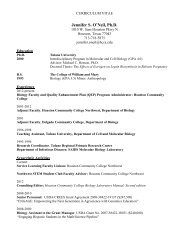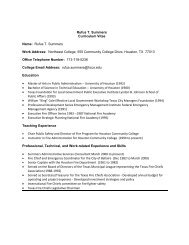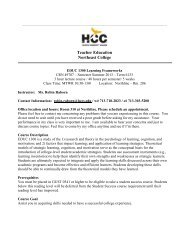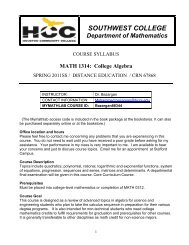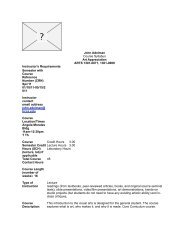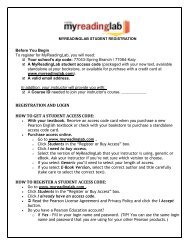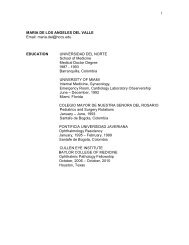Chapter 9 Materiality and Risk - HCC Learning Web
Chapter 9 Materiality and Risk - HCC Learning Web
Chapter 9 Materiality and Risk - HCC Learning Web
- No tags were found...
Create successful ePaper yourself
Turn your PDF publications into a flip-book with our unique Google optimized e-Paper software.
<strong>Chapter</strong> 9<strong>Materiality</strong> <strong>and</strong> <strong>Risk</strong> Review Questions9-1 The parts of planning are: accept client <strong>and</strong> perform initial planning,underst<strong>and</strong> the client’s business <strong>and</strong> industry, assess client business risk,perform preliminary analytical procedures, set materiality <strong>and</strong> assess acceptableaudit risk <strong>and</strong> inherent risk, underst<strong>and</strong> internal control <strong>and</strong> assess control risk,gather information to assess fraud risk, <strong>and</strong> develop overall audit plan <strong>and</strong> auditprogram. Evaluation of materiality is in the fifth part of planning. <strong>Risk</strong> assessmentis in part three (client business risk), part five (acceptable audit risk <strong>and</strong> inherentrisk), part six (control risk), <strong>and</strong> part seven (fraud risk).9-2 <strong>Materiality</strong> is defined as: the magnitude of an omission or misstatement ofaccounting information that, in light of the surrounding circumstances, makes itprobable that the judgment of a reasonable person relying on the informationwould have been changed or influenced by the omission or misstatement."Obtain reasonable assurance," as used in the audit report, means thatthe auditor does not guarantee or insure the fair presentation of the financialstatements. There is some risk that the financial statements contain a materialmisstatement.9-3 <strong>Materiality</strong> is important because if financial statements are materiallymisstated, users' decisions may be affected, <strong>and</strong> thereby cause financial loss tothem. It is difficult to apply because there are often many different users of thefinancial statements. The auditor must therefore make an assessment of thelikely users <strong>and</strong> the decisions they will make. <strong>Materiality</strong> is also difficult to applybecause it is a relative concept. The professional auditing st<strong>and</strong>ards offer littlespecific guidance regarding the application of materiality. The auditor must,therefore, exercise considerable professional judgment in the application ofmateriality.9-4 The preliminary judgment about materiality is the maximum amount bywhich the auditor believes the financial statements could be misstated <strong>and</strong> stillnot affect the decisions of reasonable users. Several factors affect the preliminaryjudgment about materiality <strong>and</strong> are as follows:1. <strong>Materiality</strong> is a relative rather than an absolute concept.2. Bases are needed for evaluating materiality.3. Qualitative factors affect materiality decisions.9-1
9-4 (continued)4. Expected distribution of the financial statements will affect thepreliminary judgment of materiality. If the financial statements arewidely distributed to users, the preliminary judgment of materialitywill probably be set lower than if the financial statements are notexpected to be widely distributed.5. The level of acceptable audit risk will also affect the preliminaryjudgment of materiality.9-5 Because materiality is relative rather than absolute, it is necessary to havebases for establishing whether misstatements are material. For example, in theaudit of a manufacturing company, the auditor might use as bases: net incomebefore taxes, total assets, current assets, <strong>and</strong> working capital. For a governmentalunit, such as a school district, there is no net income before taxes, <strong>and</strong> thereforethat would not be an available base. Instead, the primary bases would likely befund balances, total assets, <strong>and</strong> perhaps total revenue.9-6 The following qualitative factors are likely to be considered in evaluatingmateriality:a. Amounts involving fraud are usually considered more important thanunintentional errors of equal dollar amounts.b. Misstatements that are otherwise minor may be material if there arepossible consequences arising from contractual obligations.c. Misstatements that are otherwise immaterial may be material if theyaffect a trend in earnings.9-7 A preliminary judgment about materiality is set for the financial statementsas a whole. Tolerable misstatement is the maximum amount of misstatement thatwould be considered material for an individual account balance. The amount oftolerable misstatement for any given account is dependent upon the preliminaryjudgment about materiality. Ordinarily, tolerable misstatement for any givenaccount would have to be lower than the preliminary judgment about materiality.In many cases, it will be considerably lower because of the possibility ofmisstatements in different accounts that, in total, cannot exceed the preliminaryjudgment about materiality.9-8 There are several possible answers to the question. One example is:Cash $500 OverstatementFixed assets $3,000 OverstatementLong-term loans $1,500 UnderstatementNote: Cash <strong>and</strong> fixed assets are tested for overstatement <strong>and</strong> long-termloans for understatement because the auditor's objective in this case is totest for overstatements of owner's equity.9-2
9-8 (continued)The least amount of tolerable misstatement was allocated to cash <strong>and</strong>long-term loans because they are relatively easy to audit. The majority of thetotal allocation was to fixed assets because there is a greater likelihood ofmisstatement of fixed assets in a typical audit.9-9 An estimate of the total misstatement in a segment is the estimate of thetotal misstatements based upon the sample results. If only a sample of thepopulation is selected <strong>and</strong> audited, the auditor must project the total samplemisstatements to the population to estimate the total misstatement. This is donefor each audit area. The misstatements in each audit area must be totaled tomake an estimate of the total misstatements in the overall financial statements. Itis important to make these estimates so the auditor can evaluate whether thefinancial statements, taken as a whole, may be materially misstated.The estimate for each segment is compared to tolerable misstatement forthat segment <strong>and</strong> the estimate of the overall misstatement on the financialstatements is compared to the preliminary judgment about materiality.9-10 If an audit is being performed on a medium-sized company that is part of aconglomerate, the auditor must make a materiality judgment based upon theconglomerate. <strong>Materiality</strong> may be larger for a company that is part of aconglomerate because even though the financial statements of the medium-sizedcompany may be misstated, the financial statements of the large conglomeratemight still be fairly stated. If, however, the auditor is giving a separate opinion onthe medium-sized company, the materiality would be lower than for the audit of aconglomerate.9-11 The audit risk model is as follows:PDR = AARIR x CRWhere PDR = Planned detection riskAAR = Acceptable audit riskIR = Inherent riskCR = Control riskPlanned detection risk A measure of the risk that audit evidence for asegment will fail to detect misstatements exceeding a tolerable amount,should such misstatements exist.Acceptable audit risk A measure of how willing the auditor is to acceptthat the financial statements may be materially misstated after the audit iscompleted <strong>and</strong> an unqualified opinion has been issued.9-3
9-11 (continued)Inherent risk A measure of the auditor's assessment of the likelihood thatthere are material misstatements in a segment before considering theeffectiveness of internal control.Control risk A measure of the auditor's assessment of the likelihood thatmisstatements exceeding a tolerable amount in a segment will not beprevented or detected by the client's internal controls.SAS 107 (AU 312) notes that the combination of inherent risk <strong>and</strong> controlrisk reflect the risk of material misstatement.9-12 Planned detection risk is a measure of the risk that the audit evidence fora segment will fail to detect misstatements exceeding a tolerable amount, shouldsuch misstatements exist. When planned detection risk is increased frommedium to high, the amount of evidence the auditor must accumulate is reduced.9-13 An increase in planned detection risk may be caused by an increase inacceptable audit risk or a decrease in either control risk or inherent risk. Adecrease in planned detection risk is caused by the opposite: a decrease inacceptable audit risk or an increase in control risk or inherent risk.9-14 Inherent risk is a measure of the auditor's assessment of the likelihoodthat there are material misstatements in a segment before considering theeffectiveness of internal control.Factors affecting assessment of inherent risk include:Nature of the client's businessResults of previous auditsInitial vs. repeat engagementRelated partiesNonroutine transactionsJudgment required to correctly record transactionsMakeup of the populationFactors related to fraudulent financial reportingFactors related to misappropriation of assets9-15 Inherent risk is set for segments rather than for the overall audit becausemisstatements occur in segments. By identifying expectations of misstatementsin segments, the auditor is thereby able to modify audit evidence by searching formisstatements in those segments.When inherent risk is increased from medium to high, the auditor shouldincrease the audit evidence accumulated to determine whether the expectedmisstatement actually occurred. The effect on audit evidence is in the oppositedirection compared to Review Question 9-12.9-4
9-16 Extensive misstatements in the prior year's audit would cause inherent riskto be set at a high level (maybe even 100%). An increase in inherent risk wouldlead to a decrease in planned detection risk, which would require that the auditorincrease the level of planned audit evidence.9-17 Acceptable audit risk is a measure of how willing the auditor is to acceptthat the financial statements may be materially misstated after the audit iscompleted <strong>and</strong> an unqualified opinion has been issued.Acceptable audit risk has an inverse relationship to evidence. If acceptableaudit risk is reduced, planned evidence should increase.9-18 When the auditor is in a situation where he or she believes that there is ahigh exposure to legal liability, the acceptable audit risk would be set lower thanwhen there is little exposure to liability. Even when the auditor believes that thereis little exposure to legal liability, there is still a minimum acceptable audit riskthat should be met.9-19 The first category of factors that determine acceptable audit risk is thedegree to which users rely on the financial statements. The following factors areindicators of this:Client's sizeDistribution of ownershipNature <strong>and</strong> amount of liabilitiesThe second category of factors is the likelihood that a client will have financialdifficulties after the audit report is issued. Factors affecting this are:Liquidity positionProfits (losses) in previous yearsMethod of financing growthNature of the client's operationsCompetence of managementThe third category of factors is the auditor's evaluation of management'sintegrity. Factors that may affect this are:Relationship with current or previous auditorsFrequency of turnover of key financial or internal audit personnelRelationship with employees <strong>and</strong> labor unions9-20 Exact quantification of all components of the audit risk model is notrequired to use the model in a meaningful way. An underst<strong>and</strong>ing of therelationships among model components <strong>and</strong> the effect that changes in thecomponents have on the amount of evidence needed will allow practitioners touse the audit risk model in a meaningful way.9-5
9-21 The auditor should revise the components of the audit risk model when theevidence accumulated during the audit indicates that the auditor's originalassessments of inherent risk or control risk are too low or too high or the originalassessment of acceptable audit risk is too low or too high.The auditor should exercise care in determining the additional amount ofevidence that will be required. This should be done without the use of the auditrisk model. If the audit risk model is used to determine a revised planneddetection risk, there is a danger of not increasing the evidence sufficiently. Multiple Choice Questions From CPA Examinations9-22 a. (4) b. (4) c (1)9-23 a. (1) b. (1) c. (1)9-24 a. (2) b. (3) c. (1) Discussion Questions And Problems9-25 a. The justification for a lower preliminary judgment about materialityfor overstatements is directly related to legal liability <strong>and</strong> audit risk.Most auditors believe they have a greater legal <strong>and</strong> professionalresponsibility to discover overstatements of owners' equity thanunderstatements because users are likely to be more critical ofoverstatements. That does not imply there is no responsibility forunderstatements.b. There are two reasons for permitting the sum of tolerablemisstatements to exceed overall materiality. First, it is unlikely thatall accounts will be misstated by the full amount of tolerablemisstatement. Second, some accounts are likely to be overstatedwhile others are likely to be understated, resulting in netmisstatement that is likely to be less than overall materiality.c. This results because of the estimate of sampling error for eachaccount. For example, the likely estimate of accounts receivable isan understatement of $7,500 + or - a sampling error of $11,500.You would be most concerned about understatement for accountsreceivable because the estimated understatement of $19,000exceeds the tolerable misstatement of $18,000 for that account.d. You would be most concerned about understatement amountssince the total estimated understatement amount ($30,000) exceedsthe preliminary judgment about materiality for understatements($20,000). You would be most concerned about accounts receivablegiven that the total misstatement for that account exceeds tolerablemisstatement for understatement.9-6
9-25 (continued)e. 1. This may occur because total tolerable misstatement wasallowed to exceed the preliminary judgment (see Part b forexplanation).2. The auditor must determine whether the actual totaloverstatement amount actually exceeds the preliminaryjudgment by performing exp<strong>and</strong>ed audit tests or by requiringthe client to make an adjustment for estimated misstatements.9-26 a. The direct projection of error = (misstatements/amount) sampled xpopulation value.($10,000/$1,000,000) x $2,500,000 = $25,000b. No, the overall financial statements are not acceptable. Includingthe projected error for inventory, the total overstatement errors are$58,000 which exceeds materiality of $50,000.c. The auditor should either propose an audit adjustment so that theunadjusted statement amount is less than materiality, <strong>and</strong>/orperform more testing to obtain a better estimate of the populationmisstatements. The additional testing will likely focus onreceivables <strong>and</strong> inventory because they have the largest estimatedmisstatements.9-27 a. The profession has not established clear-cut guidelines as to theappropriate preliminary estimates of materiality. These are mattersof the auditor's professional judgment.The illustrative materiality guidelines in Fig 9-2 (p. 253) areused in applying materiality for the problem. Other guidelines maybe equally acceptable.STATEMENTCOMPONENTEarnings from continuingoperations before taxesCurrent assetsCurrent liabilitiesTotal assetsPERCENTGUIDELINES3 - 6%3 - 6%3 - 6%1 - 3%DOLLAR RANGE(IN MILLIONS)$12.5 - $ 25.1$67.6 - $135.2$36.5 - $72.9$38.6 - $115.8b. The allocation to the individual accounts is not shown. The difficultyof the allocation is far more important than the actual allocation.There are several ways the allocation could be done. The mostlikely way would be to allocate only on the basis of the balancesheet rather than the income statement. Even then the allocationcould vary significantly. One way would be to allocate the same9-7
9-27 (continued)amount to each of the balance sheet accounts on the consolidatedstatement of financial position. Using a materiality limit of$12,500,000 before taxes (because it is the most restrictive) <strong>and</strong>the same dollar allocation to each account excluding retainedearnings, the allocation would be approximately $595,000,000 toeach account. There are 21 account summaries included in thestatement of financial position, which is divided into $12,500,000.An alternative is to assume an equal percentage misstatementin each of the accounts. Doing it in that manner, total assets shouldbe added to total liabilities <strong>and</strong> owners' equity, less retainedearnings. The allocation would be then done on a percentage basis.c. Auditors generally use before tax net earnings instead of after taxnet earnings to develop a preliminary judgment about materialitygiven that transactions <strong>and</strong> accounts being audited within asegment are presented in the accounting records on a pretax basis.Auditors generally project total misstatements for a segment <strong>and</strong>accumulate all projected total misstatements across segments on apretax basis <strong>and</strong> then compute the tax effect on an aggregate basisto determine the effects on after tax net earnings.d. By allocating 75% of the preliminary estimate to accounts receivable,inventories, <strong>and</strong> accounts payable, there is far less materiality to beallocated to all other accounts. Given the total dollar value of thoseaccounts, that may be a reasonable allocation. The effect of suchan allocation would be that the auditor might be able to accumulatesufficient competent evidence with less total effort than would benecessary under part b. Under part b, it would likely be necessaryto audit, on a 100% basis, accounts receivable, inventories, <strong>and</strong>accounts payable. On most audits it would be expensive to do thatmuch testing in those three accounts.It would likely be necessary to audit accounts such as cash<strong>and</strong> temporary investments on a 100% basis. That would not becostly on most audits because the effort to do so would be smallcompared to the cost of auditing receivables, inventories, <strong>and</strong> accountspayable.e. It is necessary for you to be satisfied that the actual estimate ofmisstatements is less than the preliminary judgment about materialityfor all of the bases. First you would reevaluate the preliminaryjudgment for earnings. Assuming no change is considered appropriate,you would likely require an adjusting entry or an expansion ofcertain audit tests.9-8
9-28 a. The following terms are audit planning decisions requiringprofessional judgment: Preliminary judgment about materiality Acceptable audit risk Tolerable misstatement Inherent risk <strong>Risk</strong> of fraud Control risk Planned detection riskb. The following terms are audit conclusions resulting from applicationof audit procedures <strong>and</strong> requiring professional judgment: Estimate of the combined misstatements Estimated total misstatement in a segmentc. It is acceptable to change any of the factors affecting audit planningdecisions at any time in the audit if indicated by changes incircumstances. The planning process begins before the audit starts<strong>and</strong> continues throughout the engagement.9-29 Acceptable audit risk is a measure of how willing the auditor is to acceptthat the financial statements may be materially misstated after the audit iscompleted <strong>and</strong> an unqualified opinion has been issued.a. True. A CPA firm should attempt to use reasonable uniformity fromaudit to audit when circumstances are similar. The only reasons forhaving a different audit risk in these circumstances are the lack ofconsistency within the firm, different audit risk preferences fordifferent auditors, <strong>and</strong> difficulties of measuring audit risk.b. True. Users who rely heavily upon the financial statements needmore reliable information than those who do not place heavyreliance on the financial statements. To protect those users, theauditor needs to be reasonably assured that the financialstatements are fairly stated. That is equivalent to stating thatacceptable audit risk is lower. Consistent with that conclusion, theauditor is also likely to face greatest legal exposure in situationswhere external users rely heavily upon the statements. Therefore,the auditor should be more certain that the financial statements arecorrectly stated.c. True. The reasoning for c is essentially the same as for b.d. True. The audit opinion issued by different auditors conveys thesame meaning regardless of who signs the report. Users cannot beexpected to evaluate whether different auditors take different risklevels. Therefore, for a given set of circumstances, every CPA firmshould attempt to obtain approximately the same audit risk.9-9
9-30 a. 1. The auditor may set inherent risk at 100% because of lack ofprior year information. If the auditor believes there is areasonable chance of a material misstatement, 100% inherentrisk is appropriate. Similarly, because the auditor does not planto test internal controls due to the ineffectiveness of internalcontrols, a 100% risk is appropriate for control risk.2. Acceptable audit risk <strong>and</strong> planned detection risk will beidentical. Using the formula:PDR = AAR / (IR x CR), if IR <strong>and</strong>CR equal 1, then PDR = AAR.3. If planned detection risk is lower, the auditor must accumulatemore audit evidence than if planned detection risk is higher.The reason is that the auditor is willing to take only a smallrisk that substantive audit tests will fail to uncover existingmisstatements in the financial statements.b. 1. Using the formula in a., planned detection risk is equal to20% [PDR = .05 / (.5 x .5) = .2].2. Less evidence accumulation is necessary in b-1 than ifplanned detection risk were smaller. Comparing b-1 to a-2for an acceptable audit risk of 5%, considerably less evidencewould be required for b-1 than for a-2.c. 1. The auditor might set acceptable audit risk high becauseRedwood City is in relatively good financial condition <strong>and</strong>there are few users of financial statements. It is common inmunicipal audits for the only major users of the financialstatements to be state agencies who only look at them forreasonableness. Inherent risk might be set low because ofgood results in prior year audits <strong>and</strong> no audit areas wherethere is a high expectation of misstatement. Control risk wouldnormally be set low because of effective internal controls inthe past, <strong>and</strong> continued expectation of good controls in thecurrent year.2. Using the formula in a-2, PDR = .05 / (.2 x .2) = 1.25. Planneddetection risk is equal to more than 100% in this case.3. No evidence would be necessary in this case, because thereis a planned detection risk of more than 100%. The reasonfor the need for no evidence is likely to be the immaterialityof repairs <strong>and</strong> maintenance, <strong>and</strong> the effectiveness of internalcontrols. The auditor would normally still do some analyticalprocedures, but if those are effective, no additional testing isneeded. It is common for auditors to use a 100% planneddetection risk for smaller account balances. It would ordinarilybe inappropriate to use such a planned detection risk in amaterial account such as accounts receivable or fixed assets.9-10
9-31 a. Acceptable audit risk A measure of how willing the auditor is toaccept that the financial statements may be materially misstatedafter the audit is completed <strong>and</strong> an unqualified opinion has beenissued. This is the risk that the auditor will give an incorrect auditopinion.b.Inherent risk A measure of the auditor's assessment of thelikelihood that there are material misstatements in a segmentbefore considering the effectiveness of internal control. This riskrelates to the auditor's expectation of misstatements in the financialstatements, ignoring internal control.Control risk A measure of the auditor's assessment of the likelihoodthat misstatements exceeding a tolerable amount in a segment willnot be prevented or detected by the client's internal controls. Thisrisk is related to the effectiveness of a client's internal controls.Planned detection risk A measure of the risk that audit evidence fora segment will fail to detect misstatements exceeding a tolerableamount, should such misstatements exist. In audit planning, thisrisk is determined by using the other three factors in the risk modelusing the formula PDR = AAR / (IR x CR).1 2 3 4 5 6Acceptable Audit <strong>Risk</strong> .05 .05 .05 .05 .01 .01IR x CR 1.00 .24 .24 .06 1.00 .24PDR = AAR / (IR x CR) .05 .208 .208 .833 .01 .042Planned Detection <strong>Risk</strong>in percent 5% 20.8% 20.8% 83.3% 1% 4.2%c. 1. Decrease; Compare the change from situation 1 to 5.2. Increase; Compare the change from situation 1 to 2.3. Increase; Compare the change from situation 1 to 2.4. No effect; Compare the change from situation 2 to 3.d. Situation 5 will require the greatest amount of evidence becausethe planned detection risk is smallest. Situation 4 will require theleast amount of evidence because the planned detection risk ishighest. In comparing those two extremes, notice that acceptableaudit risk is lower for situation 5, <strong>and</strong> both control <strong>and</strong> inherent riskare considerably higher.9-11
9-32 a. Low, medium, <strong>and</strong> high for the four risks <strong>and</strong> planned evidencehave meaning only in comparison to each other. For example, anacceptable audit risk that is high means the auditor is willing toaccept more risk than in a situation where there is medium riskwithout specifying the precise percentage of risk. The same is truefor the other three risk factors <strong>and</strong> planned evidence.b.1 2 3 4 5 6Acceptable Audit <strong>Risk</strong> H H L L H MIR x CR L M H M M MPDR = AAR / (IR x CR) H M L L M MPlanned Evidence L M H H M ML = low, M = medium, H = highc.EFFECT ONPDR(1) Increase(2) Decrease(3) NA(4) Decrease(5) No effectEFFECT ONEVIDENCEDecreaseIncreaseDecreaseIncreaseNo effect9-33<strong>Risk</strong> Factor Related Audit <strong>Risk</strong> Model Component1. Acceptable audit risk2. Control risk3. Acceptable audit risk4. Inherent risk5. Planned detection risk6. Acceptable audit risk7. Inherent risk8. Inherent risk9. Planned detection risk10. Control risk9-12
9-34CONTROLRISKINHERENTRISKACCEPTABLEAUDIT RISKPLANNEDEVIDENCEa.b.c.d.e.f.g.h.i.j.NNDNNDIIIDN or INNINDIIIIDDNNINNDNNIIDIDDIIIC• Cases9-35FACTOREFFECT ON THERISK OF MATERIALMISSTATEMENTAUDIT RISKMODELCOMPONENT1. Henderson is a new client. Increases Inherent risk2. Henderson operates in aregulated industry, whichincreases regulatory oversight<strong>and</strong> need for compliance withregulations.3. The company’s stock is publiclytraded.4. The company is more profitablethan competitors, but recentgrowth has strained operations.5. The company has exp<strong>and</strong>ed itsuse of derivatives <strong>and</strong> hedgingtransactions.6. Henderson has added competentaccounting staff <strong>and</strong> has aninternal audit function with directreporting to the audit committee.IncreasesIncreasesIncreasesIncreasesDecreasesAcceptable auditriskAcceptable auditriskAcceptable auditriskInherent riskControl risk9-13
9-35 (continued)FACTOR7. The financial statements containseveral accounting estimates thatare based on managementassumptions.8. The company has struggled intracking property, plant &equipment.9. Henderson acquired a regionalelectric company.10. The audit engagement staff haveexperience in auditing energy<strong>and</strong> public companies.11. Partner review of key accountswill be extensive.EFFECT ON THERISK OF MATERIALMISSTATEMENTIncreasesIncreasesIncreasesDecreasesDecreasesAUDIT RISKMODELCOMPONENTInherent riskControl riskInherent riskPlanned detectionriskPlanned detectionrisk.9-36 Computer prepared Excel worksheets (P936a.xls <strong>and</strong> P936b.xls) arecontained on the Companion <strong>Web</strong>site.a. See Worksheet 9-36A on pages 9-19 <strong>and</strong> 9-20. It is important torecognize that there is no one solution to this requirement. Thedetermination of materiality <strong>and</strong> allocation to the accounts is alwaysarbitrary. In this illustration, the auditor makes estimated adjustmentsfor problems noted by analytical procedures. This is an importantstep as the potential adjustments reduce income before taxes, <strong>and</strong>thus materiality. The illustrated solution recognizes that withdownward adjustments, actual income may be much closer to thecontractual amount required for an additional contribution to theemployee's pension plan. This creates a sensitivity that will need tobe watched carefully as the audit progresses. The allocation to theaccounts is particularly arbitrary. It is noteworthy that the sum ofallocated amounts equals 1.5 times materiality. It is assumed thatthis is consistent with the audit firm's internal policies.b. The level of acceptable audit risk is based on an evaluation of threefactors:1. The degree to which external users rely on the statements.2. The likelihood that the client will have financial difficultiesafter the audit report is issued.3. The auditor's evaluation of management's integrity.9-14
9-36 (continued)Stanton Enterprise is a public company <strong>and</strong> therefore has a highdegree of reliance by external users on its financial statements. TheCompany's operating results <strong>and</strong> financial condition indicate thatthere is very little likelihood of financial difficulty in the immediatefuture. With regard to management's integrity, although there hasbeen some concern with Leonard Stanton's past bankruptcy, thecarefully monitored relationship has been good for the four yearsStanton has been a client. On that basis, it appears managementintegrity is good.Overall, then, an acceptable audit risk level of medium wouldseem appropriate.c. See Worksheet 9-36B on pages 9-21 <strong>and</strong> 9-22 that shows bothhorizontal <strong>and</strong> vertical analysis of the 2008 audited <strong>and</strong> the 2009unaudited financial statements, as well as computation ofapplicable ratios. Following are the key observations to be made:Overall Results Stanton Enterprises apparently had an extremelysuccessful year in 2009. Sales increased by 36.4 percent, grossmargin increased by 4 absolute percentage points, <strong>and</strong> incomebefore taxes increased by 138.5 percent. Return on total assets<strong>and</strong> return on equity increased <strong>and</strong> are at admirable levels. Theseresults allowed the Company to increase its dividends by 25percent (recognizing that more shares were outst<strong>and</strong>ing) <strong>and</strong> totalstockholder's equity by 101.9 percent. Furthermore, the Company'scurrent, quick, cash <strong>and</strong> times interest earned ratios are up, <strong>and</strong> itsdebt to equity ratio is down, indicating that the Company isextremely sound from a liquidity st<strong>and</strong>point.Trade Accounts Receivable In the face of such growth, tradeaccounts receivable increased by 59.3 percent, <strong>and</strong> at the sametime, accounts receivable turnover slowed <strong>and</strong> days to collectincreased somewhat. However, the allowance for uncollectibleaccounts was only .3 percent of gross receivables at the end of2009, down from 1.0 percent at the end of 2008. This implies thatthe allowance may be significantly understated for 2009 <strong>and</strong> mustbe looked at very carefully during the current audit. This reviewwould include considering whether a liberalization of credit policieswas used to help increase sales.Property, Plant <strong>and</strong> Equipment The Company made a significantadditional investment in property, plant <strong>and</strong> equipment, increasingthem by 30.5 percent. These new assets will need to be verifiedduring the current audit. It is noteworthy that accumulated depreciation9-15
9-36 (continued)increased by only 16.1 percent. This could indicate that depreciationon the new assets was not recorded, but may not, depending ondates of acquisition <strong>and</strong> depreciation method used. Depreciationmust be tested considering these facts as determined.Goodwill Goodwill also increased significantly, by $855,000. Thisimplies that the Company made an acquisition during the year. Thiscould explain the increase in operating assets, <strong>and</strong> any suchtransaction must be examined in detail as part of the audit. Also,the goodwill from prior transactions must be considered duringeach audit as to its amortization <strong>and</strong> recoverability.Accounts Payable Accounts payable went down from 2008 to 2009.This doesn't seem reasonable at all given an increase in businessactivity. It is very possible there are unrecorded liabilities at the endof 2009, <strong>and</strong> this must be an area of major emphasis during theaudit.Bank Loan Payable It seems somewhat strange for the Company tohave an outst<strong>and</strong>ing balance on its bank loan payable at the end of2009 given its excellent operating results. It is possible this was theresult of an acquisition, or they simply haven't paid it off. In anycase, verifying this balance is a relatively easy audit procedure.Federal Income Taxes Payable <strong>and</strong> Income Tax Expense TheCompany's effective tax rate for 2006 was 34 percent. Income taxexpense is only 22.5 percent of income before taxes. Federalincome taxes payable on the balance sheet is significantly lower at12-31-09 than would be expected based on 2008. These bothindicate that the Company has not made its final tax accrual for2008, <strong>and</strong> this area will require careful attention during the audit.Common Stock Common stock increased by 25 percent. It ispossible that this occurred in connection with an acquisition (seeGoodwill), or in some other way. The issuance of new shares <strong>and</strong>surrounding circumstances will need to be understood <strong>and</strong> examined.Sales Whenever there is a drastic increase in business activity,there is an increased risk of problems. It is possible that controlswill lapse or not be carefully observed. It is possible thattransactions will not be carefully accounted for. Therefore, in asituation such as Stanton's it is important to underst<strong>and</strong> the natureof the changes that took place <strong>and</strong> to do a careful review ofcontrols. It will be especially important to thoroughly test cutoffs ifboth sales <strong>and</strong> purchase transactions.9-16
9-36 (continued)d.Cost of Goods Sold <strong>and</strong> Gross Profit Consistent with the commentsunder sales, the auditors must determine why the gross profitpercent has made such a significant improvement. Tests of costs <strong>and</strong>inventories will be more extensive than in more stable circumstances.Pension Cost It appears that the Company exceeded the contractualamount for additional pension contribution. Yet, pension cost is alesser percent of sales in 2009 than in 2008. This may indicate thatan accrual for additional pension cost was not made. As pensioncost is a complex <strong>and</strong> important area, it will be verified in detailduring the audit.ACCEPTABLEAUDIT RISKINHERENTRISKANALYTICALPROCEDURESDetail tie-inMediumMediumSee Note 5ExistenceMediumMediumSee Note 5CompletenessMediumMediumSee Note 5AccuracyMediumMediumSee Note 5ClassificationMediumMediumSee Note 5CutoffMediumHighHighRealizable valueMediumHighHighRightsMediumMediumSee Note 5Tolerable misstatement:Trade accounts receivable $80,000Allowance for uncollectibleaccounts 15,000Total $95,000RATIONALE1. Acceptable audit risk is medium for the engagement, therefore, it ismedium for accounts receivable <strong>and</strong> all of its related objectives.2. Inherent risk for the engagement would be considered medium forthe following reasons:9-17
9-36 (continued)a. Stanton's background problems.b. Stanton's autocratic management style.c. Some indication of deficiencies in the control environment,particularly rejection of recommendation to establish an internalaudit function.3. Inherent risk for cutoff is considered high due to the Company'srapid growth in 2009 <strong>and</strong> the general frequency of cutoff errors.4. Inherent risk for realizable value is considered high because of theCompany's rapid growth <strong>and</strong> the amount of judgment involved inestablishing the allowance for uncollectible accounts.5. The analytical procedures performed are preliminary only, <strong>and</strong> don'tprovide substantive evidence. However, they can indicate areaswhere possible problems exist. In other words, they can't lower risk,but can increase it. In this case, they corroborate the high inherentrisk level specified for cutoff <strong>and</strong> realizable value.Stanton EnterprisesWorksheet 9-36ADetermination of <strong>Materiality</strong> <strong>and</strong>Allocation to the Accounts12/31/2009DETERMINATION OF MATERIALITY:Income before taxes $8,004,277Possible adjustments - estimated.See Worksheet 9-36b:Increase allowance foruncollectible accounts (60,248) Increase to 1.7%of trade accountsreceivable.Increase accounts payable (1,069,997) Reflect sameincrease as costof goods sold.Pension cost NA Can't estimate.May or may notbe required.Adjusted net income before taxes $6,874,0325 percent $ 343,702Round down to $ 340,000Note: A key consideration is whether theCompany will be required to make itsadditional pension contribution. As moreinformation is obtained, the amountconsidered material may be reduced toassure any possible misstatements inearnings are considered in light of thatcontractual obligation.9-18
9-36 (continued)Stanton EnterprisesWorksheet 9-36A, cont.ALLOCATION TO THE ACCOUNTS:Prelim.12/31/09TolerableMisstatementCash $243,689 10000 Easy to audit at low cost.Trade accounts receivable 3,544,009 80000 Large tolerable misstatement (TM) because accountis large <strong>and</strong> requires extensive sampling to audit.Allowance for uncollectible accounts (120,000) 15000 Fairly low TM because of inherent risk.Inventories 4,520,902 100000 Large TM because account is large <strong>and</strong>requires extensive sampling to audit.Prepaid expenses 29,500 5000 Easy to audit at low cost.Total current assets 8,218,100Property, plant <strong>and</strong> equipment, at cost 12,945,255 100000 Small TM as a percent of account balancebecause most of balance is unchanged fromprior year & audit of additions is relatively low cost.Less: accumulated depreciation (4,382,990) 50000 Fairly tight TM due to possible risk of8,562,265 misstatement. See 9-36B.Goodwill 1,200,000 20000 Fairly tight TM due to possible risk ofTotal assets $17,980,365 misstatement. See 9-36B.Accounts payable $2,141,552 70000 LargeTM because account is large <strong>and</strong>requires extensive sampling to audit.Bank loan payable 150,000 0 Easy to audit at low cost.Accrued liabilities 723,600 20000 Easy to audit at low cost.Federal income taxes payable 1,200,000 40000 Fairly tight TM due to possible risk ofmisstatement. See 9-35B.Current portion of long-term 240,000 0 Easy to audit at low cost.Total current liabilities 4,455,152Long-term debt 960,000 0 Easy to audit at low cost.Stockholders' equity:Common stock 1,250,000 0 Easy to audit at low cost.Additional paid-in capital 2,469,921 0 Easy to audit at low cost.Retained earnings 8,845,292 NATotal stockholders' equity 12,565,213Total liabilities <strong>and</strong> stockholders' equity $17,980,365 $510,000 (1.5 x $340,000)9-19
9-36 (continued)Stanton EnterprisesWorksheet 9-36BAnalysis of Financial Statements<strong>and</strong> Audit Planning Worksheet12/31/2009BALANCE SHEETPreliminary12/31/09 %Audited12/31/08 %%ChangeCash $243,689 1.4 $133,981 1.1 81.9Trade accounts receivable 3,544,009 19.7 2,224,921 17.7 59.3Allowance for uncollectible accounts (120,000) -0.7 (215,000) -1.7 -44.2Inventories 4,520,902 25.1 3,888,400 31.0 16.3Prepaid expenses 29,500 0.2 24,700 0.2 19.4Total current assets 8,218,100 45.7 6,057,002 48.3 35.7Property, plant <strong>and</strong> equipment:At cost 12,945,255 72.0 9,922,534 79.1 30.5Less, accumulated depreciation (4,382,990) -24.4 (3,775,911) -30.1 16.18,562,265 47.6 6,146,623 49.0 39.3Goodwill 1,200,000 6.7 345,000 2.7 247.8$17,980,365 100.0 $12,548,625 100.0 43.3Accounts payable $2,141,552 11.9 $2,526,789 20.1 -15.2Bank loan payable 150,000 0.8 0 0.0 --Accrued liabilities 723,600 4.0 598,020 4.8 21.0Federal income taxes payable 1,200,000 6.7 1,759,000 14.0 -31.8Current portion of long-term debt 240,000 1.3 240,000 1.9 0.0Total current liabilities 4,455,152 24.8 5,123,809 40.8 -13.0Long-term debt 960,000 5.3 1,200,000 9.6 -20.0Stockholder's equity:Common stock 1,250,000 7.0 1,000,000 8.0 25.0Additional paid-in capital 2,469,921 13.7 1,333,801 10.6 85.2Retained earnings 8,845,292 49.2 3,891,015 31.0 127.312,565,213 69.9 6,224,816 49.6 101.9$17,980,365 100.0 $12,548,625 100.0 43.39-20
9-36 (continued)Stanton EnterprisesWorksheet 9-36B, cont.COMBINED STATEMENT OF INCOMEAND RETAINED EARNINGSPreliminary12/31/09 %Audited12/31/08 %%ChangeSales $43,994,931 100.0 $32,258,015 100.0 36.4Cost of goods sold 24,197,212 55.0 19,032,229 59.0 27.1Gross profit 19,797,719 45.0 13,225,786 41.0 49.7Selling, general <strong>and</strong>administrative expenses 10,592,221 24.1 8,900,432 27.6 19.0Pension cost 1,117,845 2.5 865,030 2.7 29.2Interest cost 83,376 0.2 104,220 0.3 -20.011,793,442 26.8 9,869,682 30.6 19.5Income before taxes 8,004,277 18.2 3,356,104 10.4 138.5Income tax expense 1,800,000 4.1 1,141,000 3.5 57.8Net income 6,204,277 14.1 2,215,104 6.9 180.1Beginning retained earnings 3,891,015 2,675,91110,095,292 4,891,015Dividends declared (1,250,000) (1,000,000)Ending retained earnings $8,845,292 $3,891,015SIGNIFICANT RATIOSCurrent ratio 1.84 1.18Quick ratio 0.82 0.42Cash ratio 0.05 0.03Accounts receivable turnover 12.41 14.50Days to collect 29.40 25.18Inventory turnover 5.35 4.89Days to sell 68.20 74.57Days to convert to cash 97.60 99.75Debt to equity ratio 0.43 1.02Tangible net assets to equity 1.34 1.96Times interest earned 97.00 33.20Efficiency ratio 2.62 2.64Profit margin ratio 0.18 0.11Profitability ratio 0.48 0.28Return on total assets 0.45 0.27Return on equity 0.64 0.54Note: Some ratios are based onyear-end balances, as 12-31-03balances are not provided.9-21
Integrated Case Application9-37PINNACLE MANUFACTURING―PART IIa. Acceptable Audit <strong>Risk</strong> <strong>and</strong> Engagement <strong>Risk</strong> Issues:External users’ reliance on financial statements:1. The company is privately held, but there is a large amount ofdebt, therefore the financial statements will be used fairlyextensively. Also, management is considering selling theMachine-Tech division, which has the potential to result inextensive use of the statements by the buyers.2. Item 4 in the planning phase indicates plans for additionaldebt financing.Likelihood of financial difficulties:1. The solar power engine business revolves around constantlychanging technology, thus making it inherently more riskythan other businesses, with a better chance of subsequentbankruptcy. Item 1 in the planning issues raises a concernabout the viability of the Solar-Electro division, but notnecessarily the entire company.2. The conclusion in Part I of the case was that the likelihood offinancial failure is low, even considering the issue with Solar-Electro.3. Item 7 in the planning phase indicates there is a debt covenantrequiring a current ratio above 2.0 <strong>and</strong> a debt-to-equity ratiobelow 1.0. The current ratio has fallen below 2.0. This couldresult in the loan being called unless a waiver of the loancovenant is granted.Management integrity:No major issue exists that would cause the auditor to questionmanagement integrity, but the auditor should have done extensiveclient acceptance procedures before accepting the client. It ispossible that Item 6 in the planning phase, turnover of internal auditpersonnel, could be intentional <strong>and</strong> increases the risk of fraudulentfinancial reporting.b. Acceptable audit risk is likely to be medium to low because of thefactors listed previously, especially the planned increase infinancing <strong>and</strong> the potential violation of the debt covenant agreement.Some might prefer an even lower acceptable risk because it is afirst year audit.9-22
9-37 (continued)c. Inherent risks are addressed by examining each of the 11 items inthe planning phase.1. Inherent <strong>Risk</strong>: No effect on inherent risk2. Inherent <strong>Risk</strong>: The primary concern is the possibility ofobsolete inventory, which affects the valuation of inventory atthe lower of cost or market.Accounts Affected: Inventory, cost of good sold3. Inherent <strong>Risk</strong>: There is a potential related party transaction,which could affect the valuation of the transaction <strong>and</strong> mayrequire disclosure as a related party transaction.Accounts Affected: Manufacturing equipment, footnote4. Inherent <strong>Risk</strong>: No effect on inherent risk5. Inherent <strong>Risk</strong>: There is a potential related party transaction,which could affect the valuation of the transaction <strong>and</strong> mayrequire disclosure as a related party transaction.Accounts Affected: Repairs <strong>and</strong> maintenance expense <strong>and</strong>accounts payable.6. Inherent <strong>Risk</strong>: Although this does not directly affect inherentrisk, it is possible that turnover of internal audit personnel couldbe intentional <strong>and</strong> increases the risk of fraudulent financialreporting. The turnover may also affect the auditor’s assessmentof control risk.Accounts Affected: All accounts7. Inherent <strong>Risk</strong>: In addition to affecting acceptable audit risk,the auditor should be concerned about the risk of fraudulentfinancial reporting due to the incentive to make certain thatall debt covenants have been met.Accounts Affected: All accounts8. Inherent <strong>Risk</strong>: A receivable outst<strong>and</strong>ing for several monthsfrom a customer making up 15% of the company’s outst<strong>and</strong>ingaccounts receivable balance may indicate a major collectionproblem, which could result in an understatement of theallowance for uncollectible accounts.Accounts Affected: Accounts receivable, bad debt expense,allowance for uncollectible accounts9-23
9-37 (continued)9. Inherent <strong>Risk</strong>: An ongoing dispute with the Internal RevenueService may require an adjustment to income tax liability or adisclosure in footnotes for a contingency, depending on thestatus of the dispute.Accounts Affected: Income tax expense <strong>and</strong> income taxespayable10. Inherent <strong>Risk</strong>: This situation involves a related partytransaction (Solar-Electro borrowed money from theWelburn division). Because this transaction was not conductedwith an outside party, it is possible that the related receivable<strong>and</strong> payable might not have been properly eliminated onPinnacle’s consolidated financial statements.Accounts Affected: Notes payable, notes receivable, interestexpense <strong>and</strong> interest income.11. Inherent <strong>Risk</strong>: This situation involves a nonroutine transactionwhere there is a risk that materials, labor <strong>and</strong>/or overheadare incorrectly applied to the property accounts.Accounts Affected: Property accounts, inventory <strong>and</strong> cost ofsales.■ Internet Problem Solution: <strong>Materiality</strong> <strong>and</strong> Tolerable Misstatement9-1 Establishing materiality for the audit of a client’s financial statement requiresconsiderable judgment. The allocation of the auditor’s preliminary judgmentabout materiality to the client’s accounts requires substantial judgment as well.For this reason, decisions about materiality are made by more experiencedauditors. The following problem affords you an opportunity to apply the conceptof materiality to an actual set of financial statements.1. Imagine that you are employed as an auditor in a CPA firm thatperforms the audit of Microsoft. Your firm’s materiality guidelinesindicate that overall engagement materiality should be set at anamount between five <strong>and</strong> ten percent of income before taxes.a. Apply your firm’s guidelines to Microsoft’s 2008 financialstatements. What percentage of income before taxes do youbelieve is appropriate? Why? What do you believe overallengagement materiality should have been for 2008?9-24
Internet Problem 9-1 (continued)Answer:Microsoft’s income before taxes for 2008 was $23.814 billion.Thus, engagement materiality could range from $714.4 million(3%) to $1.429 billion (6%). Although student responses willvary, a higher materiality seems appropriate given Microsoft’smarket position <strong>and</strong> overall financial condition.b. Given Microsoft’s 2008 balance sheet, what asset lineitems would be allocated the highest amount of tolerablemisstatement? Why?Answer:The two largest asset line items are “Cash <strong>and</strong> short-terminvestments” at $23.662 billion <strong>and</strong> “Accounts Receivable” at$13.589 billion. These accounts would likely receive thelargest allocation of tolerable misstatement. A large allocationof tolerable misstatement to “Goodwill” which has a balanceof $12.108 billion is also likely due to the valuation issues.(Note: Internet problems address current issues using Internet sources. Because Internetsites are subject to change, Internet problems <strong>and</strong> solutions may change. Currentinformation on Internet problems is available at www.pearsonhighered.com/arens.)9-25


